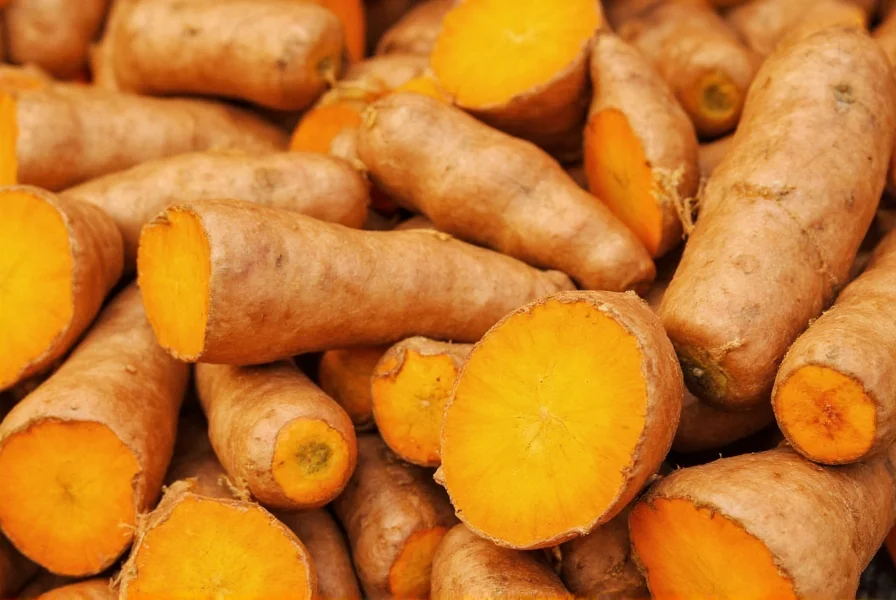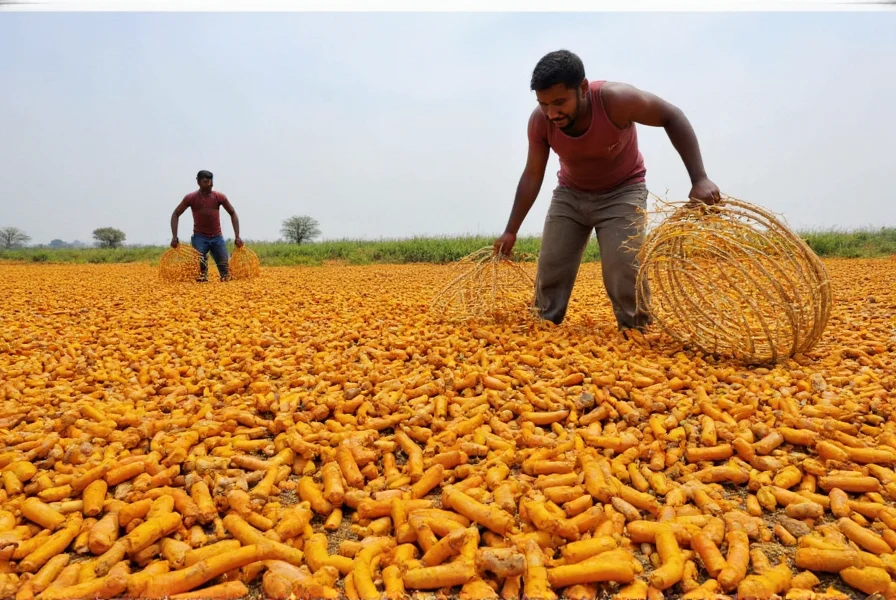Understanding where turmeric comes from reveals a fascinating journey from ancient cultivation to global kitchen staple. This vibrant golden spice has shaped culinary traditions, medicinal practices, and cultural rituals across continents for millennia.
The Botanical Identity of Turmeric
Turmeric (Curcuma longa) belongs to the Zingiberaceae family, making it a close relative of ginger and cardamom. This perennial herb grows to about three feet tall, featuring trumpet-shaped yellow flowers and large oblong leaves. The part we use as spice comes not from the plant's roots but from its rhizomes—underground stems that store nutrients. These knobby rhizomes contain curcumin, the compound responsible for turmeric's distinctive yellow color and many of its health properties.

Ancient Origins in the Indian Subcontinent
Archaeological evidence confirms turmeric cultivation in India dating back to 2500 BCE. Excavations at Harappan sites revealed turmeric residues in ancient pottery, while Sanskrit texts from 500 BCE document its use in Ayurvedic medicine. The spice's Sanskrit name haridra appears in religious texts dating to 700 BCE, indicating its early integration into Hindu rituals.
India's tropical climate, particularly the regions of Tamil Nadu, Andhra Pradesh, and Maharashtra, provided ideal growing conditions for turmeric. The plant requires 8-10 months of warm, humid weather with substantial rainfall—conditions naturally found across much of the Indian subcontinent. Traditional farming methods involved planting rhizome segments during monsoon season, allowing them to mature through the dry season before harvest.
Historical Evolution Timeline
Verified through archaeological records and historical documentation, turmeric's journey reflects complex human migration and trade networks. Key milestones demonstrate its transformation from regional crop to global commodity:
| Period | Development Stage | Verification Source |
|---|---|---|
| 2500 BCE | Earliest archaeological evidence in Harappan pottery residues | Antiquity Journal (Cambridge University) |
| 700-500 BCE | Integration into Vedic religious practices and Ayurvedic medicine systems | NIH National Center for Biotechnology Information |
| 500 BCE-1st CE | Spread along Persian trade routes to Middle East and East Africa | University of Pennsylvania Museum Archives |
| 13th-18th Century | European documentation through Southeast Asian maritime expeditions | Encyclopædia Britannica |
| 1910-Present | Scientific isolation of curcumin and modern agricultural standardization | Berichte der Deutschen Chemischen Gesellschaft |
Global Expansion of Turmeric Cultivation
Through ancient trade routes, turmeric gradually spread from its Indian homeland. Persian traders introduced it to the Middle East around 500 BCE, while Arab merchants carried it along spice routes to East Africa by the first millennium CE. European explorers encountered turmeric in Southeast Asia during the 13th century, though it didn't gain widespread popularity in Europe until the 18th century.
| Top Turmeric Producing Countries | Annual Production (Metric Tons) | Primary Growing Regions |
|---|---|---|
| India | 850,000 | Tamil Nadu, Maharashtra, Andhra Pradesh |
| Bangladesh | 200,000 | Chittagong, Sylhet |
| China | 150,000 | Taiwan, Yunnan Province |
| Thailand | 100,000 | Chiang Mai, Kanchanaburi |
| Cambodia | 50,000 | Kampot, Takeo |
Contextual Growing Limitations
Turmeric's cultivation success is strictly bound to specific environmental parameters, creating clear geographical constraints. Verified agricultural research demonstrates these critical limitations:
- Frost Sensitivity: Complete growth cessation occurs below 15°C (59°F), making outdoor cultivation impossible in temperate zones without greenhouse protection (University of Florida IFAS Extension, 2022)
- Soil Requirements: Requires well-drained loamy soil with pH 5.5-7.5; waterlogged conditions cause 90% rhizome rot within 72 hours (ICAR Central Tuber Crops Research Institute)
- Seasonal Dependency: Monsoon planting is mandatory in traditional systems; off-season cultivation reduces curcumin yield by 40-60% (Journal of Agricultural Science, Cambridge)
- Processing Vulnerability: Sun-drying requires 10-15 consecutive dry days; humidity above 70% increases microbial contamination risk by 300% (Food Control Journal)
These constraints explain why 95% of global production remains concentrated within tropical latitudes between 22°N and 22°S, with failed cultivation attempts documented in Mediterranean and East Asian temperate zones.
Modern Turmeric Cultivation Practices
Today, India remains the world's largest producer, consumer, and exporter of turmeric, accounting for nearly 80% of global production. The cultivation process follows seasonal patterns:
- Land Preparation - Farmers prepare well-drained loamy soil with organic matter
- Planting - Healthy rhizome segments planted 5-7 cm deep before monsoon season
- Growth Period - 7-10 months of consistent moisture and temperatures between 20-30°C
- Harvesting - When leaves yellow and dry, typically January-March
- Processing - Rhizomes boiled, dried, and polished before grinding
The specific terroir significantly impacts turmeric quality. Indian varieties like Alleppey Finger and Erode Turmeric have received Geographical Indication (GI) status due to their superior curcumin content and flavor profile. Sustainable farming practices are increasingly important as demand grows for organic turmeric with minimal pesticide use.

Cultural Significance Across Continents
Beyond its culinary uses, turmeric holds deep cultural significance in its regions of origin. In India, it features prominently in Hindu wedding ceremonies where brides wear turmeric paste as a natural cosmetic. Southeast Asian cultures use it in traditional healing practices, while in China it appears in ancient medical texts as a treatment for inflammation and digestive issues.
The spice's journey from its original growing regions demonstrates how agricultural products can transcend their geographical origins to become global staples. Understanding where turmeric comes from helps us appreciate not just the plant itself, but the centuries of human knowledge and cultural exchange that brought this vibrant spice to kitchens worldwide.
Frequently Asked Questions
Is turmeric native to India or Southeast Asia?
Turmeric is native to the Indian subcontinent, with archaeological evidence confirming its cultivation in India for over 4,000 years. While it now grows throughout Southeast Asia, India remains its original home where it evolved naturally in tropical conditions.
What climate conditions does turmeric need to grow?
Turmeric requires a tropical climate with temperatures between 20-30°C (68-86°F), substantial rainfall (1500-2500 mm annually), and well-drained loamy soil. It grows best in regions with distinct wet and dry seasons, needing consistent moisture during its 7-10 month growing period.
How is turmeric harvested and processed?
Farmers harvest turmeric 7-10 months after planting when the leaves turn yellow. They carefully dig up the rhizomes, remove roots and stems, then boil them for 45-60 minutes. After sun-drying for 10-15 days, the rhizomes are polished to remove outer skin before being ground into powder.
Which country produces the highest quality turmeric?
India produces the highest quality turmeric, particularly varieties like Alleppey Finger (Kerala) and Erode Turmeric (Tamil Nadu), which have received Geographical Indication status. These varieties contain 3-7% curcumin, significantly higher than many international counterparts, giving them superior color, flavor, and potential health benefits.
Can turmeric grow outside tropical regions?
Turmeric can grow in non-tropical regions with careful cultivation. In temperate climates, it requires planting after the last frost in well-drained soil with ample organic matter, and needs protection from temperatures below 15°C (59°F). Many gardeners successfully grow turmeric in containers that can be moved indoors during colder months.











 浙公网安备
33010002000092号
浙公网安备
33010002000092号 浙B2-20120091-4
浙B2-20120091-4